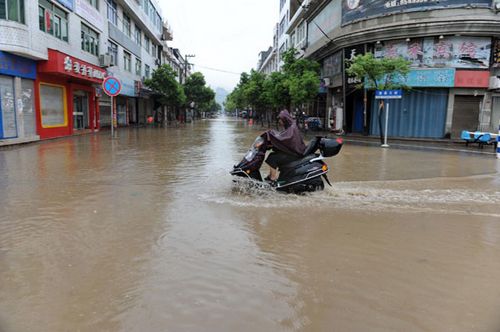
Gales and rainstorms have lashed coastal regions in East China following the arrival of two tropical storms early Friday, forcing the evacuation of 867,000 people as of 6 pm Friday, according to the tally by the Ministry of Civil Affairs.
Strong tropical storm Saola, which has weakened from a typhoon, made landfall in the city of Fuding in East China's Fujian province at 6:50 am Friday, packing winds of 90 km per hour near its center, according to the provincial meteorological station.
It is expected to move northwest at a speed of 15 to 20 km per hour, bringing heavy rains to northern Fujian and Jiangxi provinces later Friday, the station said.
As of 6 pm Friday, 214,000 residents in Fujian have been relocated, according to the ministry. The provincial flood control and drought relief headquarters previously put the number of evacuees at 306,000.
The station said local governments should prepare for storm-triggered natural disasters such as floods and mudslides.
In the neighboring province of Zhejiang, about 716,000 people were affected by Saola, among whom 349,000 were evacuated, the Ministry of Civil Affairs said.
Saola previously made landfall at 3 am Thursday in Hualien, Taiwan, bringing heavy rains and forcing most schools and offices on the island to close.
Typhoon Damrey, the 10th typhoon of the year, made landfall near Xiangshui county in East China's Jiangsu province around 9:30 pm Thursday.
The storm brought torrential rains to Jiangsu and southern Shandong province early Friday morning, local meteorological authorities said.
Strong winds and rainstorms from the typhoon have lashed the cities of Linyi, Rizhao, Qingdao and Weifang in Shandong, the National Commission for Disaster Reduction said in a report.
It also forced the relocation of 180,000 residents in the province, according to the report.
Authorities in Shandong had ordered more than 40,000 ships to return to harbor as of Friday morning, the provincial department of civil affairs said.
Twenty-nine flights were canceled at the Qingdao Liuting International Airport Thursday night. However, no flights were affected Friday morning, the airport said.
At least four trains on a railway between the cities of Yanzhou and Rizhao in Shandong were delayed as a result of the storm.
Damrey also forced the evacuation of 124,000 people in the cities of Lianyungang, Yancheng and Nantong in Jiangsu province, according to the National Commission for Disaster Reduction.
Shandong Yellow River water conservancy bureau said the severe rainstorms brought by Damrey have created challenges in terms of controlling flooding on the river's downstream reaches.
The lower reaches of the Yellow River have received three flood peaks over the course of this summer's flood season. Water levels in some large-and medium-sized reservoirs in Shandong have reached or exceeded warning levels.
A rain-triggered mudslide has killed three people and left one missing in the city of Qingzhou in Shandong.
The National Commission for Disaster Reduction and the Ministry of Civil Affairs initiated a level four emergency response to the storms at 11 am Friday and sent teams to affected provinces to direct relief work.
It is rare to see two typhoons make landfall in China within 24 hours, said Zhang Chang'an, deputy director of the typhoon and marine meteorology center of the China Meteorological Administration.
In 2006, typhoons Bopha and Saomai hit the country successively, causing severe losses, according to Zhang.
"It costs considerable manpower and resources to tackle two typhoons at once," Zhang said.
Premier Wen Jiabao on Wednesday urged local governments to fully prepare for the approaching typhoons.
Wen asked local authorities to closely monitor the typhoons and their effect on major rivers, as well as issue related alerts in a timely manner.
The typhoons and upcoming flood peaks on major rivers may bring the risk of geological disasters and create challenges for urban flood control and drainage facilities, he said.
Frequent disasters have tested the government's emergency response capabilities, said Liu Min, a professor at East China Normal University.
Liu said the government is ultimately responsible for ensuring security during disasters, adding that the recent floods have alerted local governments of the importance of reducing disaster risks.

Copyright ©1999-2011 Chinanews.com. All rights reserved.
Reproduction in whole or in part without permission is prohibited.